 What does a board need in order to lead?
What does a board need in order to lead?
No, I’m not talking about what boards are supposed to DO. Leading is not about “doing” but about “being” and “thinking.” What do board members need in order to BE leaders?
This is not just an academic question for us, as we are right now in the process of building Creating the Future’s founding board. And so I wanted to share something I created for our board, to help them lead.
ED’s Keep It All In Their Heads
One of the most common attributes of entrepreneurial founders and CEOs is that they have the whole organization – all its programs, all its funding sources, all its plans – all of that is in their heads. Those leaders see the organization’s interrelated pieces as one integrated whole, understanding instantaneously not only where each piece fits into that whole, but whether or not new information fits at all.
Not surprisingly, CEOs don’t always take the time to explain all that complexity to the board. It’s not just a lot to grasp, but it’s also all interrelated. Start explaining one thing and that leads to another thing, and before you know it, the board’s eyes have glazed over.
Feeling overwhelmed, board members grab onto the few pieces they DO understand, frequently asking relentless questions about those few issues. EDs / founders are often left wondering, “We have SO much more important stuff to talk about. Why are they so stuck on this one stupid little thing?”
What I Did for Our Board
Creating the Future is a brand new organization with a brand new board. Dimitri and I have been running the show on our own for over a year now, looking forward to having a board to help us make the decisions that will indeed create the future.
If we are to accomplish our mission and lead this sector to its potential, we need to transition from “The Hildy and Dimitri Show” to a highly coordinated and far more distributed movement for change. For that success to occur as quickly as possible, the board will need an almost instantaneous transmittal of all the data in Dimitri and my heads.
Sadly, I never learned the proper technique for the Vulcan Mind Meld. And so, for the past 2 weeks, I have been creating the next best thing – a status update on every single project we are doing, within the context of WHY we are doing it all.
The report starts by providing context.
• Here is the vision for what we want the world to be like because of our work
• Here are the conditions we intend to create in the world, to ensure we are walking towards that vision.
• Here is our short term mission, focusing on just one of those conditions, to shift it dramatically in a defined period of time.
• Here are the groups whose work we intend to influence.
• And here are the programs that will influence them, as well as the necessary infrastructure for making it so.
These two graphics were included at the beginning of the report, to show the board visually how it all fits together. (Sorry about the quality for reading purposes – but mostly I just want to show that it’s nothing fancy – hand-drawn flow charts.)

Then, for each of those groups, I created a chart with the following info:

The resulting report was 30 pages and counting (still not entirely done). And while that took a lot of work, board members can now, at a glance, instantly understand not only the breadth and depth of what we are doing, but the context – the WHY of what we’re doing. They see how it all fits, just as an ED might do in his/her head.
And now, every month we can just fill in the “status” column with updates.
Benefits
There are so many benefits to a tool like this, not the least of which is that board members understand why CEOs and EDs and founders often feel overwhelmed. The first thing Creating the Future’s board members wanted to know was when we find time to eat or sleep. That’s actually not a small thing; board members often call consultants around the time of an ED’s evaluation, confessing they have no clue what the ED actually does.
From there, though, imagine new board members joining the board, wanting to come up to speed as quickly as possible. What a great thing to be able to share with them!
It is also a great tool for ensuring the organization is succession-ready. Because none of us knows when our time is up, if we really want the mission to be accomplished, that won’t happen if everything is in the CEO’s head when the meteor hits.
Most important, though, this is a tool that allows the board to get their heads out of the weeds, and to see the whole forest – not just what we’re doing, but why. They can see the plan and see where everything fits. By inserting graphics, they can not only read the plan, but see it as instantly as the CEO sees it in his/her own head.
So what do board members need in order to lead? A big part of the answer is all about context.
Give board members a long list of all the things you are doing, and they will focus on the doing.
But give them the context for WHY you are doing that work, and they will begin applying that context to other issues that arise. As it is with the ED/CEO, they will be looking to see how everything fits.
I just wanted to share this with you all, as it was so well-received by our board. Several of them noted, “Nobody does this. It would be so helpful!”
So what do you think? Does this look like something that might be helpful for your org?
The report I sent to the board is not completely complete yet. When it’s done, we will be posting it to our site, along with a short video explaining a bit of the context. And the graphics will be more readable, so stay tuned!

I love the Vulcan Mind Meld analogy! You know I’m going to borrow that.
Re the list an ED is doing – yes, I find ED’s who complain about micromanaging boards are constantly fuelling that micromanagement with operational details the board doesn’t need and shouldn’t have. Boards do not need distractions from innovation and strategy, and I’m referring to details that aren’t relevant to oversight or evaluation.
What I really liked about being ED was being in the best position to see the patterns and interconnections and symbiosis. But I expect I didn’t always explain the mental leaps that resulted very well.
I am more and more convinced that graphics are essential if we want to communicate memorably to everyone in the room – no matter what type of room or what type of attendees. There will always be those who want text and spreadsheets but even they need graphics to help them think differently. I’ve got to get better at graphics!
Jane:
I used to worry about getting “good” at graphics. Until I realized that people were fighting over the hand-drawn flip charts I did during a facilitation. And the graphics here are literally drawn on a white board and photographed. I think we spend way too much time trying to make things presentable when “understandable” and “identifiable” is more than enough. (BTW the new watchword in our office is “Done is better than perfect.” And I am LOVING that one!)
Again, I think if we can find simple ways to share the bigger picture of how everything interrelates – THAT is what’s really needed. Pretty is a bonus, but more and more I’m seeing it’s just not a necessity.
HG
I really appreciate this post. Sharing information in a clear and streamlined way not only brings the board onto the same page as the ED (and potentially other staff) but also helps to balance power relations. If everyone in the room is starting (perhaps literally) on the same page, then everyone has a more equal shot at contributing to the future direction the organization. Finding creative and effective ways to do this, given the diversity of backgrounds, experiences and interpretations that board members bring to the table, is key.
Would love your feedback of you and your readers this post (http://communitiesknow.com/2011/08/16/sustainable-communities-are-dynamic-communities-iii/), which addresses similar issues, on a broader scale.
Laura:
I couldn’t agree more. We so often hear about board and staff operating as a team, and they can’t really do that unless they start with some base level of shared clarity – everyone being on the same page, as you suggest. Thanks for this!
HG
Hildy, love, love, love the status chart! Love the simplicity. We all wallow in way too much complexity and yes I can just see those board members’ eyes start to glaze over. Thanks for the breath of fresh air and I can’t wait to see you next week!
And we can’t wait to have you here, Gail!!
🙂